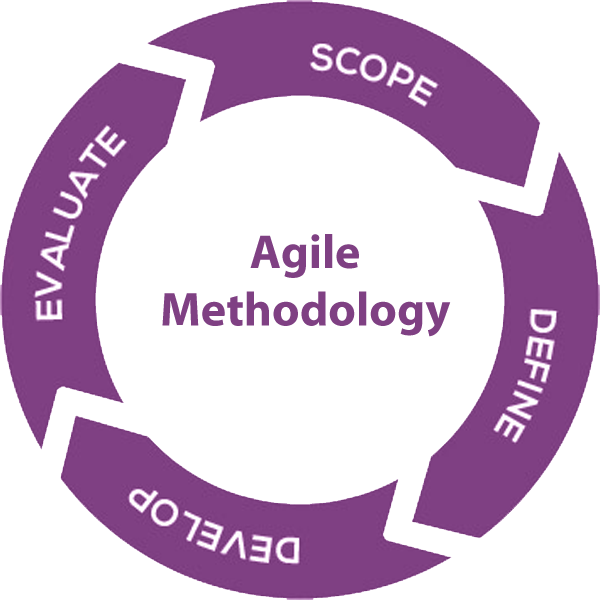What is Agile Transformation?
When the Agile Manifesto was introduced almost 14 years ago, it proposed a radical methodology change as an alternative to traditional project management. With agile, project requirements and solutions evolve through collaboration in development cycles that break tasks into small increments. While this methodology helps businesses manage unpredictability, it also requires those businesses to adopt a different mindset in order to be successful.
While agile is designed to drive collaboration, transparency, and quality within product and software development lifecycles, it isn’t always the right answer for every organization. In fact, the signers of the Manifesto will tell you that while there is value in examining what agile is, there is just as much value in examining what it is not. It is not a “silver bullet,” nor is it necessarily the cheapest option – it’s a framework to align teams to deliver working software more collaboratively and with better quality. With agile there are tremendous benefits to the business: you can generate positive results for IT, gain a faster time to market, and increase your competitive differentiation.
But how do you decide if introducing agile gradually (known as an agile adoption), or implementing agile across your organization (known as an agile transformation) is right for you?

A good place to start is by examining your company’s product development or project management culture. If your organization has demonstrated success using the predictive, traditional waterfall development methodology, there may be real value in continuing the same way: assemble your teams, work on discovery, generate detailed requirements, design the solution, develop the code, test the code, and then deploy it to your production environment. In other words, if your organization’s SDLC isn’t broken, then for goodness’ sake don’t fix it!
Advantages and Benefits of Agile Transformation
Revenue
The iterative nature of agile development means features are delivered incrementally, enabling some benefits to be realized early as the product continues to develop.
Speed-to-market
Research suggests about 80% of all market leaders were first to market. As well as the higher revenue from incremental delivery, agile development philosophy also supports the notion of early and regular releases, and ‘perpetual beta’.
Quality
A key principle of agile development is that testing is integrated throughout the lifecycle, enabling regular inspection of the working product as it develops. This allows the product owner to make adjustments if necessary and gives the product team early sight of any quality issues.
Visibility
Agile development principles encourage active ‘user’ involvement throughout the product’s development and a very cooperative collaborative approach. This provides excellent visibility for key stakeholders, both of the project’s progress and of the product itself, which in turn helps to ensure that expectations are effectively managed.
Risk Management
Small incremental releases made visible to the product owner and product team through its development help to identify any issues early and make it easier to respond to change. The clear visibility in agile development helps to ensure that any necessary decisions can be taken at the earliest possible opportunity, while there’s still time to make a material difference to the outcome.
Cost Control
The above approach of fixed timescales and evolving requirements enables a fixed budget. The scope of the product and its features are variable, rather than the cost.
Business Engagement/Customer Satisfaction
The active involvement of a user representative and/or product owner, the high visibility of the product and progress, and the flexibility to change when change is needed, create much better business engagement and customer satisfaction. This is an important benefit that can create much more positive and enduring working relationships.
More Enjoyable!
The active involvement, cooperation and collaboration make agile development teams a much more enjoyable place for most people. Instead of big specs, we discuss requirements in workshops. Instead of lengthy status reports, we collaborate around a task-board discussing progress. Instead of long project plans and change management committees, we discuss what’s right for the product and project and the team is empowered to make decisions. In my experience this makes it a much more rewarding approach for everyone. In turn this helps to create highly motivated, high performance teams that are highly cooperative.
Flexibility / Agility
In traditional development projects, we write a big spec up-front and then tell business owners how expensive it is to change anything, particularly as the project goes on. In fear of scope creep and a never-ending project, we resist changes and put people through a change control committee to keep them to the essential minimum. Agile development principles are different. In agile development, change is accepted. In fact, it’s expected. Because the one thing that’s certain in life is change. Instead the timescale is fixed and requirements emerge and evolve as the product is developed. Of course for this to work, it’s imperative to have an actively involved stakeholder who understands this concept and makes the necessary trade-off decisions, trading existing scope for new.
Our Capabilities : A company's technology organization should support its business strategy, not constrain it. TMV. focuses first on the strategic needs of our clients' businesses to determine the technology capabilities needed to support their long-term goals. We help companies address technology-related decisions and ensure their IT organizations and operating models are agile and effective, equipping them to cut through the noise of fleeting technology trends to create enduring results.
